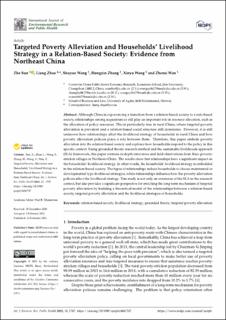Targeted Poverty Alleviation and Households’ Livelihood Strategy in a Relation-Based Society: Evidence from Northeast China
Peer reviewed, Journal article
Published version
Permanent lenke
https://hdl.handle.net/11250/2991245Utgivelsesdato
2021Metadata
Vis full innførselSamlinger
Originalversjon
Sun, Z. Zhao, L. Wang, S. Zhang, H. Wang, X. Wan, Z. (2021). Targeted Poverty Alleviation and Households’ Livelihood Strategy in a Relation-Based Society: Evidence from Northeast China. International Journal of Environmental Research and Public Health (IJERPH), 18 (4). https://doi.org/10.3390/ijerph18041747Sammendrag
Abstract: Although China is experiencing a transition from a relation-based society to a rule-based
society, relationships among acquaintances still play an important role in resource allocation, such as
the allocation of policy resources. This is particularly true in rural China, where targeted poverty
alleviation is prevalent and a relation-based social structure still dominates. However, it is still
unknown how relationships affect the livelihood strategy of households in rural China and how
poverty alleviation policies plays a role between them. Therefore, this paper embeds poverty
alleviation into the relation-based society and explores how households respond to the policy in this
specific context. Using grounded theory research method and the sustainable livelihoods approach
(SLA) framework, this paper contains in-depth interviews and field observations from three povertystricken villages in Northeast China. The results show that relationships have a significant impact on
the households’ livelihood strategy. In other words, the households’ livelihood strategy is embedded
in the relation-based society. The types of relationships induce households to choose maintained or
developmental type livelihood strategies, while relationships influence how the poverty alleviation
policies affect the livelihood strategy. This study is not only an extension of the SLA in the research
context, but also provides a significant perspective for enriching the long-term mechanism of targeted
poverty alleviation by building a theoretical model of the relationships between a relation-based
society, targeted poverty alleviation and the livelihood strategies of households.

